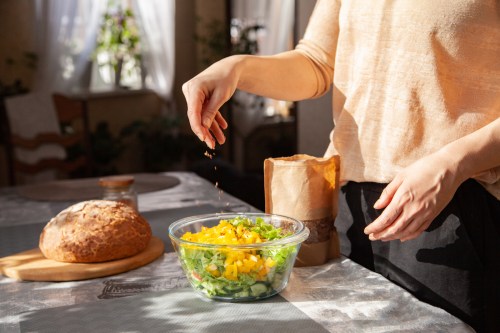The Best Anti-Inflammatory Foods for Dry Skin, According to a Top Dermatologist
Discover the best anti-inflammatory foods for dry skin according to a doctor and top dermatologist who says diet plays a big role in skin health.

‘Tis the season for cozy sweaters, holiday gatherings, and peppermint-flavored everything, but with the onset of winter often comes inflamed, dry skin as well. Between the falling temperatures and the increase in illness this time of year, your skin can suffer more than usual, but you aren’t fated to flakey, red complexions if you know how to take care of your skin. Thankfully, world-renowned dermatologist, author, and skin-care entrepreneur, Harold Lancer, MD, has everything we need to know about the best anti-inflammatory foods for dry skin, no matter the season.
Experts in This Article
board-certified dermatologist, fellow of the American Academy of Dermatology, founder of Lancer Glow.
Why inflammation happens in the first place
A lot is coming at us in our modern world that can lead to dry, inflamed skin. Dr. Lancer says that some of the leading causes of skin inflammation include pollution, stress, UV exposure, genetics, and exposure to chemicals and allergens—cosmetics included. He explains that these elements all trigger a series of reactions in your immune system, and if your body isn’t strong enough to fight back, this can also lead to an increase in inflamed skin.
The consequences of letting inflammation go untreated
“If you don’t treat the skin properly with anti-inflammatory topical medication or ingredients, the skin will continue to react, itch, and be impaired causing discomfort and even pain in severe cases,” Dr. Lancer says. “Inflammation also leads to breakdown in collagen, elastin, and hyperpigmentation causing visible unwanted damage.” However, Dr. Lancer is a firm believer in going beyond topical treatments to restore your glow for the long term.
“Diet is key in preventing flare-ups in those who are genetically sensitive,” says Dr. Lancer, who adds that avoiding inflammatory foods, like added or refined sugar, ultra-processed foods, and industrial oils, will help keep the skin healthy and reduce the triggers that cause the inflammation process. “There’s no magic pill here,” Dr. Lancer says. “Eat the good stuff, leave out the junk. Simple.”
But it’s not all about avoidance. There are plenty of amazing foods out there to add in that will do wonders for your complexion while boosting your overall health along the way.
The best anti-inflammatory foods for dry skin
Green veggies (and vegetables in general)
In terms of foods that fight inflammation, Dr. Lancer is all about eating the rainbow, but he’s especially fond of green vegetables, which are good for reducing inflammation and oxygenating the body. If you’re averse to eating greens, Dr. Lancer recommends drinking them instead by making or purchasing green juices or smoothies.
Salmon, sardines, and other Omega 3-rich fish
Dr. Lancer says that omega-3 fatty acids are crucial for improving skin health and boosting your body’s total immunity. His favorite sources of omega-3s are fish such as salmon, sardines, and sea bass, but you can also find omega-3s in flax and chia seeds, as well as walnuts if you’re looking for a plant-based option.
Lean proteins
Protein is a critical nutrient for healthy skin, according to Dr. Lancer. A 2020 study published in Nutrients says that this macronutrient is critical for protecting our skin’s constitution1 as we age and repairing its tissues, as well as helping us build and repair muscle. Along with omega-3-rich foods, Dr. Lancer often opts for chicken and loves a grilled chicken salad when looking for an anti-inflammatory meal while dining out. If you’re making chicken at home, don’t forget to save the bones for an anti-inflammatory broth to use in soups, stews, and even when cooking rice.
Dr. Lancer’s final pro tip for fighting inflammation with food
The preparation of food can be as important as what you eat when the goal is to get as many nutrients from your diet as possible, and to that end, Dr. Lancer recommends cooking at home as much as possible. “I also tell my clients to try to meal prep ahead of time,” he says. “This takes out the quick impulse of ‘not knowing what to eat’ and going for junk food.”
Research from a 2022 study also published in Nutrients found eating outside of the home2 to be associated with lower intakes of fiber, produce, and micronutrients along with higher intakes of sugar and sugar-sweetened beverages, alcohol, and overall calories. While dining out and ordering takeout are inevitable parts of our busy lives, taking the time to do a little meal prep at the beginning of the week can help make eating an anti-inflammatory diet easier and more affordable.
For more intel on embracing anti-inflammatory eating habits, check out the video below:
- Cao, Changwei et al. “Diet and Skin Aging-From the Perspective of Food Nutrition.” Nutrients vol. 12,3 870. 24 Mar. 2020, doi:10.3390/nu12030870↩︎
- Gesteiro, Eva et al. “Eating out of Home: Influence on Nutrition, Health, and Policies: A Scoping Review.” Nutrients vol. 14,6 1265. 16 Mar. 2022, doi:10.3390/nu14061265↩︎
Sign Up for Our Daily Newsletter
Get all the latest in wellness, trends, food, fitness, beauty, and more delivered right to your inbox.
Got it, you've been added to our email list.










